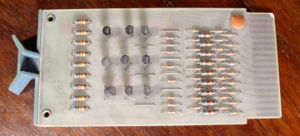FLIP CHIP
Flip-Chip was a DEC registered trademark, named after the "flipchip" component mounting technique which quite rapidly faded from fame. The name was retained although the majority of Flip-Chips never really were flipchip-mounted as it became apparent that the flipchip mounting technique was highly unreliable. Flip-chips were used in the DEC PDP-7 (Referred to in documentation as the "FLIP CHIP"), PDP-8, PDP-9 and PDP-10, beginning on August 24, 1964.
In practice, they performed generic, simple functions, similar to an integrated circuit. They were approximately 4 inches long and 2.5 inches wide. Each had 36 connectors, 18 on each side.
Contents
Naming
There appeared to be some confusion inside DEC at the time, as various manuals refer to it as "FLIP CHIP", "Flip Chip", "FLIP-CHIP", "Flip-Chip" and "Flip Chip", with trademark and registered trademark symbols.
Flip-Chip families

The various families were color-coded, and the first letter denoted a color, which was also visible on the handle.
A series
The A stands for Amber. The A series were used for analog functions - ADCs, DACs, amplifiers etc.
| Part Number | Description |
| A123 | Positive logic multiplexer |
| A131 | unknown |
| A200 | Op. amp. |
| A206 | Op. amp. |
| A207 | Op. amp. |
| A214 | unknown |
| A215 | unknown |
| A404 | sampler??? |
| A613 | 12 bit DAC converter |
| A615 | unknown |
| A618 | 10 bit DAC converter |
| A619 | 10 bit DAC converter |
| A620 | 10 bit DAC converter |
| A621 | 10 bit DAC converter |
| A702 | reference supply??? |
| A704 | reference supply??? |
| A811 | 10 bit ADC converter |
| A990 | amplifier |
| A992 | amplifier |
B series
The B stands for Blue. The B series were used as core logic in the higher-end CPUs.
G series
The G stands for Green. The G series were used for "anything with non-standard voltages", I think.
M series
The M stands for magenta. Part of this line is simple TTL-level logic, while later on, it became quite complex, see list of DEC part numbers. They replaced the R series which used discrete transistors with integrated circuits.
- Power supply: 5 V
- Operate at up to 6 MHz
R series
The R stands for Red. Slower logic than the B series, but cheaper. Used extensively in the I/O circuitry of computers.
- Slower logic than B series, cheaper
- Used in a variety of systems, e.g. PDP-8
- Power supply 10 and -15 volts
- Operational to 2 megahertz
- Signal level 0 volts, logic 0 and -3 volts, logic 1
- Typical price $20 to $30
| Part Number | Description |
| R001 | Diode network |
| R002 | Diode network |
| R107 | Inverter |
| R111 | Expandable NAND/NOR gate |
| R113 | NAND/NOR gate |
| R121 | NAND/NOR gate |
| R122 | NAND/NOR gate |
| R123 | Input bus |
| R131 | Exclusive OR |
| R141 | AND/NOR gate |
| R151 | Binary to octal decoder |
| R181 | DC carry chain |
| R200 | Flipflop |
| R201 | Flipflop |
| R202 | Dual flipflop |
| R203 | Triple flipflop |
| R204 | Quadruple flipflop |
| R205 | Dual flipflop |
| R302 | Dual delay multivibrator |
| R303 | Integrating one shot |
| R401 | Variable clock |
| R405 | Crystal clock |
| R601 | Pulse amplifier |
| R602 | Pulse amplifier |
| R603 | Pulse amplifier |
| R650 | Bus driver |
S series
The S series is identical to the R seriese except that its transistors switch faster and lower resistance resistors, allowing more cards to be wired in series and operate somewhat faster.
